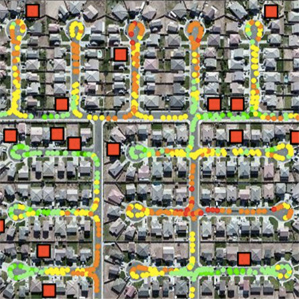Qualcomm Proposes a Cell-Phone Network by the People, for the People
Mobile chipmaker Qualcomm and some U.S. wireless carriers are investigating an idea that would see small cellular base stations installed in homes to serve passing smartphone users. That approach is believed to be a more efficient way of meeting the rising demand for data and fixing patchy coverage than building more traditional cell-phone towers.

Qualcomm’s chief technology officer, Matt Grob, pitched the idea at an event in Santa Clara, California, on Tuesday, showing off a base station small enough to be integrated into a set top box or home router. “We are working extensively with operators on this particular project,” Grob told MIT Technology Review after his presentation. Qualcomm has installed 20 of the small prototypes in office buildings around its San Diego campus. A person driving or walking through the area receives a stronger signal on his phone, and faster downloads, as his device hops between the many small base stations, each with a range of tens of meters. “Our next step is to do a larger test, with a network operator and an infrastructure vendor,” says Grob.
Mobile carriers already sell small cellular base stations for personal use, and sometimes hand them out for free to people with a poor signal at home but they are pitched as personal devices. Users can configure them to serve only devices they specify. AT&T enables that feature by default, but Verizon and Sprint do not, meaning that some people on those networks may already be operating open base stations from their homes without realizing it. Grob proposes making it explicit that the devices are public infrastructure and redesiging the devices to better suit that role. “I may still buy the device, but its coverage and capacity is available for passersby,” says Grob. “That doesn’t replace the existing network infrastructure, but it significantly adds to it.”
The approach could be attractive to mobile networks experiencing rapidly growing demand for mobile data, driven by the popularity of smartphones, tablets, and online video. AT&T reports that mobile data use on its network has climbed by 250 times in five years.
Even a relatively small number of such small base stations in homes and offices could significantly boost mobile coverage, says Grob. Qualcomm worked with AT&T on a feasibility study in which Qualcomm engineers surveyed a San Diego neighborhood where some AT&T customers already had private home base stations. Although only a few people had those devices, enough of their signal reached the streets that, were they configured to be available to any subscriber, they could effectively act as a second cellular network in that area, says Grob. “If these base stations were open, it would be a good network.”
Because home base stations are connected to domestic broadband, a mass rollout of such devices would likely require coöperation between broadband providers or cable networks and mobile carriers. But Grob says that it could be an attractive new business for such companies, who could install mobile base stations into home routers or set top boxes they provide to customers and then make deals with mobile networks. “You could call the operators and say, I will let your customers roam and it will only cost you this much.”
Qualcomm has calculated that bandwidth offered this way could be cheaper than the cost of providing it with additional conventional towers. However, a broadband provider would have to deploy technology to guarantee people that home Internet bandwidth wouldn’t suffer from overuse by nearby mobile phone users.
Martin Garner, who researches mobile services for analysts CCS Insight, says that Grob’s idea asks mobile carriers to change a lot about their operations and business model, but they may decide it’s worth it.
“Consumers hosting open, public cells in their house goes against the traditional culture of the telco,” Garner says. “But I also think most of them are painfully aware of the rate of data growth, and know they need to embrace other ways of doing things.”
Many major carriers are rolling out public Wi-Fi hotspots and other services to defray the load on their towers, points out Garner, “but over time, there may also be a need to use small cells, which use different spectrum, giving more capacity.”
Keep Reading
Most Popular
Large language models can do jaw-dropping things. But nobody knows exactly why.
And that's a problem. Figuring it out is one of the biggest scientific puzzles of our time and a crucial step towards controlling more powerful future models.
How scientists traced a mysterious covid case back to six toilets
When wastewater surveillance turns into a hunt for a single infected individual, the ethics get tricky.
The problem with plug-in hybrids? Their drivers.
Plug-in hybrids are often sold as a transition to EVs, but new data from Europe shows we’re still underestimating the emissions they produce.
Stay connected
Get the latest updates from
MIT Technology Review
Discover special offers, top stories, upcoming events, and more.